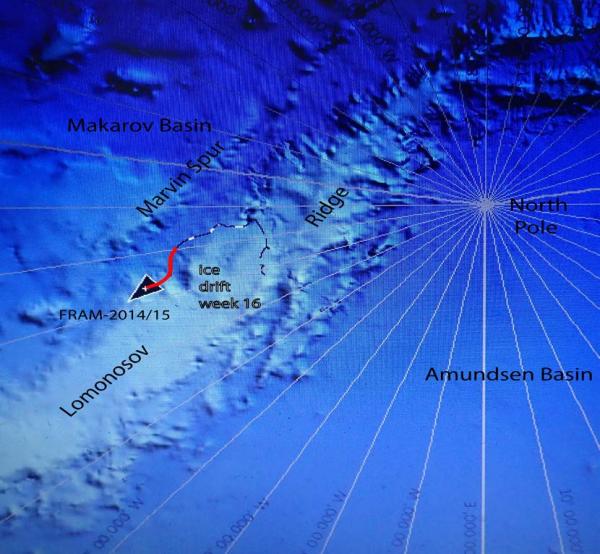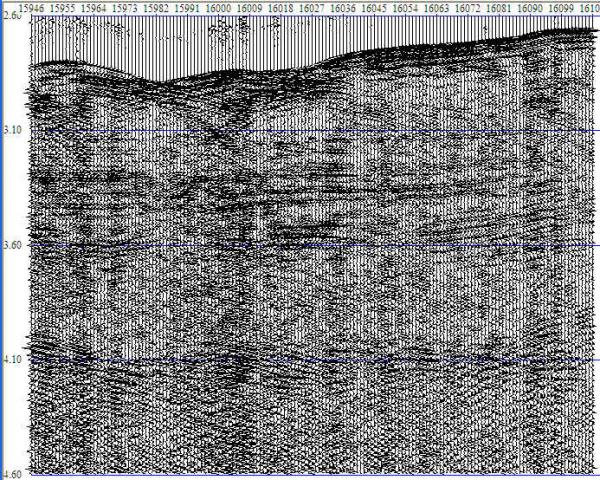
(15 - 22 Dec. 2014)
Ice drift
The ice camp moved about 23 nautical miles (42 km) during the week (Fig. 1) along the slope of Lomonosov Ridge facing the Makarov Basin. The drift speed was relatively high on Monday (0.4 knots), slowed down on Tuesday 0.2 knots), but came to a complete standstill on Friday. At its slowest, the camp moved 25 meters in 9 hours, and the next 25 meters took 17.168 seconds (4.7 hours). The ice drift remained slow during the weekend. This speed change is remarkable because the wind speed remained between 10 and 14 knots from the north and northeast, slightly higher than before the slowdown. As during the previous week, the surface air pressure pattern was a high extending from the East Siberian Sea to the Beaufort Sea with relatively weak gradients towards the Pole giving us calm weather (wind speeds < 10-14 knots in the sector NW to NE).

Fig. 1. Drift track (red) of FRAM-2014/15 during week 16 (15-22 December, 2014).
Sea ice dynamics
Also this week, no known ice movements affected our neighborhood.
Camp life
Temperatures stayed at 28-29° C Monday through Wednesday, with a warm spell on Thursday (- 14° C) and then falling to - 34° C on Saturday. The week has been characterized by an atmosphere of great expectations in lieu of the forthcoming air drop by the P-3 Orion of the 333 Sq generously provided by the Norwegian Air Force. The flight was initially scheduled for Friday 19th December, but delayed until after the weekend. 24 pieces including work tents (2), heaters and miscellaneous spares are expected. A 700+ meter long drop zone has been checked out to be marked with lights. There appears to be no open water areas in our neighborhood at the moment.
The expected arrival of new work space facilities has made us hold off any activities like sediment coring or deployment of the camera sled. Besides, we are drifting in about 2.100 meter water depth with a 500+ meter thick cover of Cenozoic sediments where no specific targets present themselves.
Part of the excitement about the air drop is simply the fact that wear and tear have done away with our supply of mittens suited for work in very low temperatures. Constantly loosing the feeling of your finger tips, is very painful and tiring.
Science
This week, the following suite of continuous measurements has been operating:
Bathymetry and sub-bottom profiling:
- four active autonomous echo sounder buoys reporting to shore via Iridium
- continuous seismic reflection measurements ( 2 km sub-bottom penetration)
Oceanography:
- two Aanderaa current meters at 800 and 1050 meter depth, respectively.
Atmosphere: (from Friday)
- measurement of incoming and outgoing radiation from the ice surface
- surface infrared skin temperature
- sun time
- Aanderaa weather station (no wind speed at the moment)
We are back with continuous seismic reflection measurements. As the drift path turned slightly east of south, we moved higher on the slope of Lomonosov Ridge and out of the zone of deformed sediments (Fig. 2). The deepest section (below 1 sec. two-way travel time sub-bottom) shows a south component of dip in contrast to the overlying infill of material with horizontal acoustic layering.

Fig. 2 Screen shot of the raw seismic data recorded along the slope of Lomonosov Ridge at the end of week 16. The upper part (shallower than 3.4 sec.) probably correlates with the Cenozoic drape on the top of the ridge. South is to the right. The shot spacing is 25 meter.
On Friday, we uploaded to an ftp-site all the data (16 Mb) logged so far by the radiation flux instruments for the Meteorological Institute, Oslo. This was our first case of direct delivery of raw data and demonstrates the potential of an ice station as an active science platform. The facility was set up by graduate student Gaute Hope and Lars-Gunnar Persson, NERSC.
Visits by the un-named polar fox have been more irregularly this week. On Friday, Audun had planned a close-up photo session where the bait was an empty egg shell filled with olive oil. The fox had a quick sniff at the egg shell, and then went straight for the camera, grabbed it and run. Audun caught up with the thief after about one hundred meter and recovered the camera - end of photo session.
Winter solistice is Sunday 21 December, from now on the light is coming. The moon comes above the horizon on 29 December and will help us along the way until mid-January.
Life is treating us well in the High Arctic.
Yngve Kristoffersen & Audun Tholfsen
Daily reports
Monday 15 December.
Position: 88° 01.8' N, 78° 05' W, temperature - 29° C, air pressure 1015 hPa, wind 15 knots from NW. Ice drift 0.4 knots towards southeast. Shooting seismic reflection all day.
Tuesday 016 December..
Position: 88° 00.0' N, 76° 21' W, temperature - 25° C, air pressure 1008 hPa, wind 13 knots from the WNW. Ice drift 0.2 knots due east. Problems with irregular seismic trigging during the early morning hours. Acquiring seismic reflection data all day.
Wednesday 17 December.
Position: 87° 58.1' N, 73° 57' W, temperature - 28° C, air pressure 1013 hPa, wind 12 knots from the NNW. Ice drift 0.2 knots towards southeast. Acquiring seismic reflection data all day. Audun moved more food from the abandoned camp to the new camp. Maintenance work on the winch. 18 pieces of cargo arrived Andøya Air Base from Bergen.
Thursday 18 December
Position: 87° 55.3' N, 73° 17' W, temperature - 23° C, air pressure 1010 hPa, wind 10 knots from the NNW. Ice drift 0.2 knots towards south. Shooting seismic reflection all day. Audun picked out the memory card from the data logger of the radiation flux instrument. All cargo (24 pieces) for the ice have arrived at the air base of the 333 Sq., Andøya.
Friday 19 December.
Position: 87° 51.2' N, 73° 18' W, temperature - 22° C, air pressure 1016 hPa, wind 14 knots from ENE. Ice drift 0.0. Shooting seismic reflection all day. Audun picked up another two loads with food from the old camp. Connected up the heat exchanger with the engine so heat from the extended radiator loop in the cabin also heats the engine. The drift is extremely slow. During the day it took over 8 hours to move 25 meters, the next 25 meters took nearly 5 hours. Audun uploaded all the radiation flux data to a NERSC ftp site.
Saturday 20 December
Position: 87° 51.1' N, 73° 13' W, temperature - 34° C, air pressure 1018 hPa, wind 7 knots from the ENE. Ice drift 0.0. Shooting seismic reflection all day. Re-adjusted the lift fan belt - a very cold job. The belt move to forward end of pulley, so an other adjustment is needed, but we need a warmer day. Audun moved another three loads of food from the old camp.
Sunday 21 December.
Position: 87° 49.7' N, 73° 01' W, temperature - 26° C, air pressure 1013 hPa, wind 13 knots from the NNE. Ice drift 0.1 knots towards the south. Shooting seismic reflection all day. Searched out for drop zone for the Orion flight coming tomorrow.

